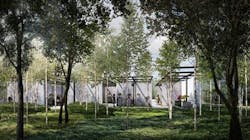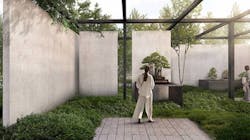Design of the National Bonsai and Penjing Museum unveiled
The U.S. Commission of Fine Arts has approved a new concept design for the National Bonsai and Penjing Museum at the U.S. National Arboretum.
Located within the U.S. National Arboretum’s Core, the museum is conceived as an immersive and cohesive garden experience. The design organizes the Museum’s program around a central court that orients the visitor to a network of paths that lead to the four exhibitions, an expanded classroom, and administrative services. The exhibitions are conceived not as buildings, but as gardens, and blur the boundaries with the larger, surrounding garden.
The design also establishes a pervasive grove of understory trees as the principal image and identity of the Museum. Mixed species surround and frame the various exhibitions and the central court. Garden walls organize a path through the display while charred wood posts and trellises rise above the exhibitions to filter light and shape a sense of enclosure.
The National Bonsai and Penjing Museum is the first project in Reed Hilderbrand’s Master Plan Update for the U.S. National Arboretum’s core.

